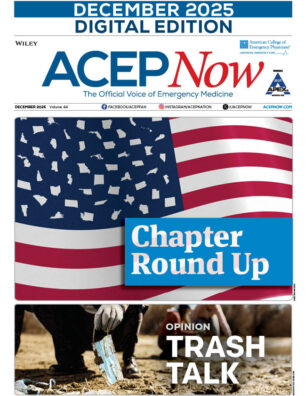The American College of Emergency Physicians has endorsed using the FAIR Health consumer database as a tool to help stabilize the medical billing reimbursement process, which has been in upheaval in recent years. The FAIR Health database, which became available in 2009, is a free website for consumers to use to research the approximate cost of out-of-network medical services in their geographic area.
Explore This Issue
ACEP News: Vol 31 – No 07 – July 2012Because the database pulls information from millions of actual medical bills, ACEP’s stance is that insurance companies should also integrate it into the system by which reimbursement rates are set for medical claims.
“We understand that the patient shouldn’t be made to pay an unfair burden. Reluctantly, we understand that the insurance companies can’t just pay actual charges with no upper limit for these services,” said David McKenzie, ACEP Reimbursement
Director. “But there has to be some mechanism to determine fair payment. Because this tool is available, it makes sense to use it.”
Emergency physicians face some unique challenges amid the changing health care landscape. Unlike most specialties, emergency providers are obligated to treat patients, regardless of their ability to pay. But when it comes to getting reimbursed for those services, emergency physicians say insurers have been unwilling to offer in-network rates or take other steps to help doctors recover their costs.
“Insurance companies should negotiate with emergency providers for in-network rates,” said ACEP President Dr. David C. Seaberg. “But what is happening in the real world is that insurance companies are not negotiating with emergency physicians.”
Although emergency care accounts for only 2% of the U.S. health care dollar, emergency physicians say they’re caught between their obligation to treat patients and a reimbursement system that sometimes treats them as interlopers.
“There’s a perception that emergency medicine is expensive and there’s a lot of patients who are there who don’t need to be,” Dr. Seaberg said. “Honestly, that’s not true.”
Health insurance companies set reimbursement rates for out-of-network services using the greatest of several options: the amount negotiated by in-network providers; adjusted “usual, customary, and reasonable” (UCR) charges; or the amount Medicare would pay for the service. But emergency providers say the first two options are too easily manipulated by insurers.
And the Medicare reimbursement rates are artificially low. Consumers are experiencing similar frustration as insurers have increasingly tied reimbursement rates to Medicare.
“There are huge disparities between using the UCR charges and Medicare-based formulas,” said Robin Gelburd, FAIR Health’s President. “There’s a tidal wave of consumer complaints.”
That’s why proponents say FAIR Health data will help.
Prior to 2009, an insurance company owned and controlled the database, which was used to set UCR rates for out-of-network services.
The data was culled from millions of actual medical billings.
But consumers and providers didn’t have access. They complained the insurance companies were basing reimbursement rates on “black box” data that only they could see.
Andrew Cuomo, then New York’s attorney general, launched an investigation into the insurance company’s ownership and use of the database. He maintained it was a conflict of interest for the insurer to control the database and use it to calculate reimbursements.
To settle the issue, the insurance company relinquished the data, and FAIR Health, a nonprofit organization, was created to manage and update the data and provide it to consumers at no cost.
Although the legal battle took place in New York, FAIR Health data covers transactions across the nation. A team of outside experts maintains and updates the information in the database so that it is current and analyzed properly. Emergency physicians are particularly interested in the FAIR Health data because their services are frequently reimbursed at the out-of-network level. That means that patients get less money from their insurance companies to cover the bill. When patients can’t or won’t pay the full amount, doctors often are forced to absorb the cost.
“It really affects emergency providers more than any other specialty,” Dr. Seaberg said.
ACEP would like to see the 80th percentile of FAIR Health added as an option for a measure of fair payment. The Medicare reimbursement rate bears virtually no relationship to real-world market conditions, doctors say. And patients are often surprised that reimbursement rates tied to Medicare do not cover more of their bills.
FAIR Health officials say they hear a lot of complaints from consumers and doctors. “It’s a very volatile, changing market out there,” said Ms. Gelburd of FAIR Health. Emergency physicians “should not be whipsawed by levels of reimbursement that don’t fairly reimburse them for their expertise.”
To watch a video of Dr. Michael J. Gerardi speaking about FAIR Health, go to www.acep.org/fairhealthvideo.
Pages: 1 2 3 | Multi-Page




No Responses to “ACEP Says FAIR Health Database Is Fair”